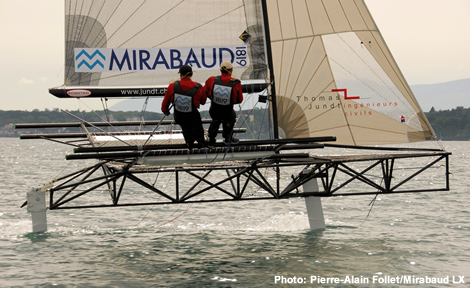
Moth development - part 2
This article follows on from part 1 published last week
Foils
In terms of how the foil shapes have developed, the Mach 2 appears to have a longer vertical component to its foils, but this is in fact an illusion - it is the same length as the Bladerider which in turn was only a few centimetres longer than it was on the Prowler. “The Mach 2 looks very high because you can ride it high and stay stable, whereas if you ride a Bladerider at that height it just feels horrible – wobbly and all over the place,” says designer Andrew McDougall. “The Mach 2 is stiffer and the foils are stiffer - not so much the horizontal foil, but the vertical foil is very solid, so you don’t need a lot in the water to maintain steerage and stability. It is like driving a really nicely tuned sportscar with really soft sticky tyres and you keep driving it faster and faster and it is so good but then you get to this point where everything lets go and then it is all over. It is like that with the Mach 2 - you can ride it high so easily and you can just send it, but then you just hit this one wave which is bigger than the rest and then it doesn’t work.”
Obviously you could go higher with the foils, which would increase righting moment and might help reduce susceptibility to waves, but then there are increased drag issues, it would be harder to balance and harder to get foiling. So MacDougall reckons that they could be perhaps 100mm longer but at present can’t see the advantage of this.
The Moths for some while have been fitted with vertical foils that are angled slightly forwards as according to Adam May (below), this encourages water to flow up them rather than air to flow down and this, combined with improved profiles, prevents them ventilating. May also believes that the advent of the ride height adjuster means that there is no longer an advantage to go for ultra high aspect ratio lifting foils and this is good as it allows the boat to be heeled to windward more, without the windward tip of the foil popping above the water – an easy way to to stall the rudder.
"If you go for a high aspect ratio lifting foil, you need to mount it on a longer vertical section to avoid the leeward tip coming out as you sail to windward with 20 degrees or so of windward heel. So your low speed gain from the high aspect ratio foils is offset against the extra vertical section drag."

There has also been talk in the past about increasing the fore and aft distance between the foils, but McDougall says it is more important to have good balance between the sail and the front foil. “We’ve shortened the distance between the wand and foils because of the raked bow [of the Mach 2] and the foil is further forward and it does have some negative and positive trade-offs. In flat water it is fantastic because the foil is very close to the centreboard so it is very positive feedback from the wand. But as the waves get bigger you really want a longer time, so it may be that we look at moving the wand out. The wand can go out 500mm from the front of the boat.”
Much work has also gone into making more precise the lengthy linkage mechanism between the wand and the flap on the trailing edge of the front lifting foil. “A few of us have got rid of that - and made the boat sail worse, because it is much more direct!” admits MacDougall. “I think a lot of us will be playing with dampening and different ways to make the connection less positive or more positive when you need it.”
Where to from here?
Adam May, who has also designed his own Moths, is one of what is believed to be few Moth pioneers looking into fitting a Moth with a solid wingmast, similar to the C-Class catamarans (or the BMW Oracle Racing tri). Other similar projects are believed to be underway in the USA and in Switzerland. An unstayed wingmast (ie with a soft sail behind it) for a Moth has already been tried by Glenn Oldfield at Composite Components. May recognises that fitting a solid wing to a Moth might not be the most practical of exercises (however remember this is the man who fitted Moth foils to an Optimist...) and it would inevitably be heavier than the present 8.5kg all-up carbon spars and sail package.
“The problem is weight and the biggest issue with the Moth is that we launch and come in capsized. If you talk to anyone in the C-Class they say ‘wings don’t like to capsize’. So I don’t think a wing is a practical solution but there are several of us who would like to do one, rather than it being a realistic thing for the future of the class.”
May says that a solid wing for a Moth would be simpler than the equivalents seen on the C-Class cats or BMW Oracle Racing’s tri.
It should be noted that even if solid wingsails are built for the Moths, it is only an experimental development and is something that is likely to be promptly outlawed by the class. May believes it more likely that wingmasts might be permitted in the future as they can be broken down into two parts and shipped in the existing Moth containers.
However a solid wingsail is exactly not the development McDougall is interested in. He is still more enthusiastic about creating a 'foiler for the masses', as he tried before with Bladerider. “I want to see a boat that is significantly cheaper, significantly more practical. I don’t think it needs to be much easier to sail – it is more the logistics: you can’t launch it very easily, you can’t store it very easily. What I really want to do is to do something that gets kids out of Opties straight into a foiling dinghy. Something where if they run into a rock with the foil they can replace it easily, as opposed to our foils whch are US$6000 - just for the foils.” He adds that he doesn’t want to dumb it down once it is on the water, but perhaps speed limit it – such as allowing it to be heavier and giving it bigger lifting foils which will get it airborne sooner, but won’t have such a dramatic top speed.
He is currently looking for funding to work up a prototype.
Theorising
When we asked McDougall if he were asked to designed a solo foiler without the constaints of the Moth rule, this was something he hadn’t contemplated. However Adam May pointed out that in comparison to the Moths, the foil born RS600 FF was initially quicker upwind and righting just through having more righting moment, although this is no longer the case. So the easiest way to turbo a Moth would be to increase the size of its racks.
While the low-rider Moth was under canvassed, for today’s nimble flying machines that is no longer the case. “We went from a low rider going upwind at 6-7 knots to now going upwind at 13-14 and with the apparent wind speeds and forces involved with that, but with the same area. It’s just that the rigs have changed massively within that,” says May. A larger rig would rapidly cause an upward weight spiral, although it would allow foil sizes to be reduced slightly.
May says he has contemplated making a two man foiler using a hull from an A-Class catamaran, putting large racks on it and a three sail rig. “I think that would be one cool-looking boat - and rather rapid! You’d buy an A-Class, with two rigs (then you could split it between two of you). I like the concept of a two man one - the idea of going upwind with the crew on the mainsheet with an efficient Una rig and going around the mark and hoisting a furled up Code Zero. We are already pretty fast downwind - faster than an 18 in certain conditions. If you hoisted a Code Zero it would be quite rapid..!”
As to how well the foil-born monohull scales up in the size – Thomas Jundt has clearly been successful with his one-time 18ft skiff on Lake Geneva and there seems little reason not to go bigger.

“It would be interesting to define what we think the key ratios are,” agrees May. “A lot of people were saying that the Moths are the only class that will do go foiling because of the weight, but it turns out it is all to do with the rig, power, righting moment – a lot of different things come into it. The RS600 was pretty easy to get on foils. Mirabaud did it – and that is in a similar region to a Moth. I started looking into a two man and everyone is in similar territory. But weight is the biggest issue.”
So, we're sure there is more to come in foiling beyond the Moth class - the question is when and why has it taken to long to happen?









Latest Comments
aardvark_issues 18/05/2010 - 22:37
Enjoyed the Mach2 love-in. Glad to be firmly under the radar!kwittnebel 11/05/2010 - 06:20
Two person foilers are alive and well. Do a writeup on the R-class skiff in NZ.Add a comment - Members log in